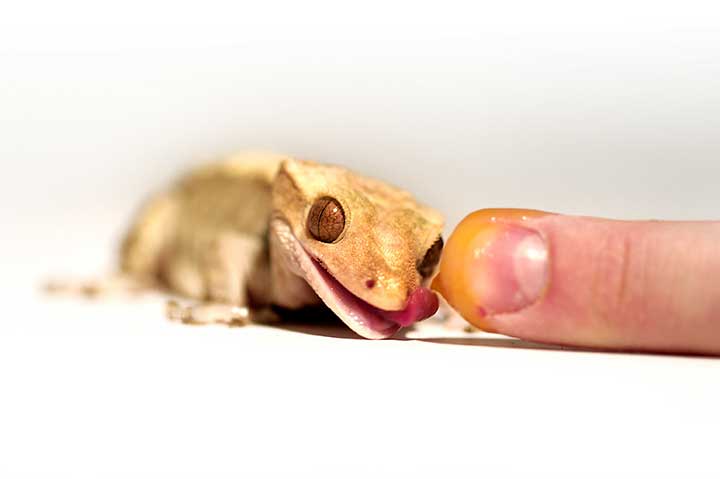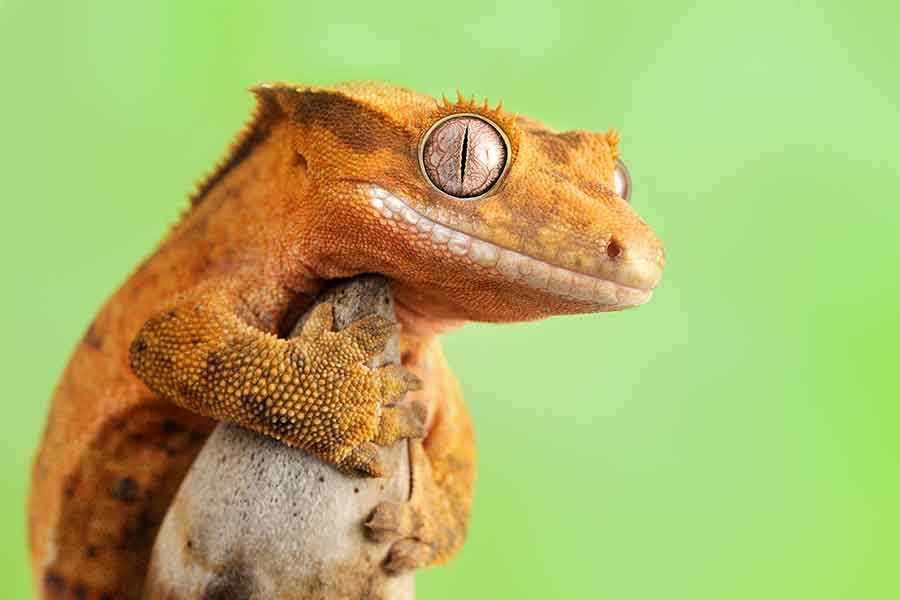Crested geckos are a low-maintenance pet, making them ideal for children or inexperienced lizard owners with limited daily care time. Its eyelashes are one of their distinguishing characteristics, which is why they are sometimes referred to as eyelash geckos. These lizards are native to New Caledonia, an island nation off Australia’s coast. Once believed to be extinct, they were “rediscovered” in 1994. Since then, their prevalence as pets has steadily risen.
Behavior and Temperament
Crested geckos exhibit a wide range of colors and patterns (morphs). Variable in size, its name derives from the fringed crest that originates above their eyes and goes down their necks and backs.
The unique toe pads and prehensile tails of crested geckos enable them to walk around vertical surfaces with ease. In addition, they are superb jumpers.
Generally, crested geckos have gentle temperaments, though they are rather shy and must be handled with caution. They dislike handling, so avoid it if possible. They may attempt to leap away from you, which could cause them harm. In contrast to other geckos, crested geckos cannot regrow their tails if they lose them due to hard handling or in an attempt to escape.
They will only bite when they perceive a threat. Although bites are non-painful and insufficient to produce blood, they are unsettling.
Enclosure

An adult requires at least a 20-gallon tall terrarium, although a larger tank is preferable. Crested geckos are arboreal, active reptiles that require a great deal of vertical room for climbing, thus a tall tank is preferable. In a tall 29-gallon terrarium, two to three crested geckos can be kept. Males are territorial, so only one male should be kept per tank. Ventilation can be provided by a glass terrarium with a screened side, however some keepers prefer screened enclosures.
Provide a variety of branches, driftwood, cork bark, bamboo, and vines of varying heights and orientations for crested geckos to climb. Add a variety of silk or robust live plants (such as Epipremnum (pothos), Philodendron, Dracaena, and Ficus) since they will seek shelter among the plants.
Each day, you must remove all uneaten food and perform spot cleaning to remove excrement. At least once every month, clean the entire terrarium and its ornaments with disinfectants safe for reptiles. Depending on the substrate, weekly or monthly replacement will be required to prevent bacterial growth.
Heating
As cold-blooded organisms, reptiles must maintain their body temperature. Crested geckos require a daytime temperature gradient of 72 to 80 degrees Fahrenheit (22 to 26.5 degrees Celsius) and a nighttime drop of 65 to 75 degrees Fahrenheit (18 to 24 degrees Celsius). Using temperature gauges, make sure that the cage does not overheat. The stress level of crested geckos increases as the temperature rises. A low-wattage red nighttime light serves as an effective heat source and allows you to observe the lizard at night, when it is most active. Do not place a heat source on the tank’s lid, as these geckos may get too close and be burned.
Light
Technically, because crested geckos are nocturnal, they do not require UVB lamps. However, other specialists believe that a modest UVB lighting level (about 5 percent) is favorable for reptile health. Any additional illumination will increase the enclosure’s temperature, so keep an eye on that. Also, create a gecko hideout so geckos can escape the light if they so choose.
Humidity
Crested geckos require a level of humidity between 50 and 70 percent. Obtain a hygrometer to monitor humidity levels everyday. Provide humidity with regular warm, filtered water misting. Depending on the design of your cage, you may need to mist it multiple times per day to maintain adequate humidity. Always ensure that the cage is adequately misted at night, when gecko activity is at its peak. Obtain an automatic mister or fogger to add humidity to the cage at timed intervals if you are absent throughout the day or unable to manually mist the enclosure.
Substrate
Most pet owners line the bottom of the cage with a substrate. When picking a substrate for a gecko, it is important to consider pet safety, simplicity of cleaning, and humidity retention. The ideal substrates for a crested gecko are bedding made of coconut fiber, moss, or peat. Additionally, newspaper and paper towels can be used, although they are not as beautiful.
If your crested gecko has a tendency to eat substrate while hunting, use sphagnum moss (alone or on top of another substrate, such as coconut fiber) or paper towels. Paper towels are recommended for juveniles because they are more likely to mistakenly ingest other substances.
Gravel (or pebbles) is not a good substrate since it is difficult to clean thoroughly and consistently. Avoid reptile sand and inorganic soil substrates, as these can be ingested.
What do crested geckos eat?

As they are nocturnal, they should be fed in the evening. Feed juveniles every day and adults every three days.
A commercial meal for crested geckos is often well-received and the simplest approach to ensure a balanced, nutritious diet. Add crickets and other predatory insects to the diet (roaches, waxworms, silkworms). Avoid feeding mealworms, as their exoskeleton is indigestible and inflexible. For diversity and to allow the gecko to use his natural hunting instincts, provide the gecko with as many prey insects at once as he gladly consumes.
Before feeding insects to your lizard, they should be gut-loaded or fed nutritious meals. Insects should be somewhat smaller than the distance between the gecko’s eyes. Three times each week, dust the insects with a calcium/vitamin D3 powder supplement to increase your reptile’s vitamin and mineral intake. Once every week, you can also dust prey items with a multivitamin powder supplement.
Fruit is consumed by crested geckos many times per week. Try pureed fruit or baby food in a container. Bananas, peaches, nectarines, apricots, papaya, mangoes, pears, and passion fruit are popular fruits.
If you are unable to locate a commercial gecko diet, offer a combination of insect prey items and fruit. This is hardly the healthiest option, but it will suffice in a pinch or for a short time. In this situation, crickets with the occasional addition of other insects are the ideal option.
Provide daily fresh water in a small shallow dish, although they will likely prefer to drink dewdrops from leaves in their humid habitat.
